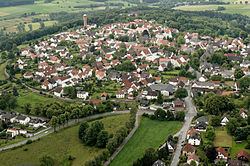Admin. region Arnsberg Time zone CET/CEST (UTC+1/+2) Population 10,619 (30 Jun 2010) | Local time Saturday 11:44 PM | |
 | ||
Elevation 280 - 440 m (−1,160 ft) Weather 4°C, Wind NE at 10 km/h, 68% Humidity Points of interest Möhne, Möhnetal, Hachtor, Gamma Fahrzeuge GmbH, Backhaus Rüthen | ||
Imagefilm r then engl
Rüthen is a town in the district of Soest, in North Rhine-Westphalia, Germany.
Contents
- Imagefilm r then engl
- Map of 59602 RC3BCthen Germany
- R then eine melancholische kleinstadt final test man
- Geography
- Division of the town
- International relations
- History
- Buildings
- Nature
- People
- References
Map of 59602 R%C3%BCthen, Germany
R then eine melancholische kleinstadt final test man
Geography
Rüthen is situated at the northeastern border of the natural preserve Arnsberger Wald between the Haarstrang and the valley of the river Möhne, approx. 20 km south of Lippstadt and 35 kilometres (22 mi) south-west of Paderborn. The highest point is the Wehberg with a height of 528.9 metres (1,735 ft), the lowest point the valley of the river Pöppelsche at 130 metres (430 ft). With an area of more than 310 square kilometres (120 sq mi) it is the largest town within the district of Soest.
Division of the town
Today Rüthen is the commune largest in area in the district of Soest with an area of 158 square kilometres (61 sq mi). After the local government reforms of 1975 Rüthen consists of the following 15 districts:
International relations
Rüthen is twinned with:
History
The city of Rüthen was first mentioned in a document of the Kloster Grafschaft (abbey earldom) in 1072. The area around Rüthen already belonged to the Erzbistum Köln(archbishopric Cologne) in the High Middle Ages. On 29 September 1200 Rüthen was given town law by the sovereign, the archbishop of Cologne Adolf I. von Altena. Starting in 1375 Rüthen belonged to the Hanse, an economic alliance of trading cities and their guilds that dominated trade along the coast of Northern Europe in the later Middle Ages. The merchants of the city had far reaching business connections and because of that were able to ensure wealth. In the following centuries, however, the importance of Rüthen decreased massively.
Like many other cities in the duchy of Westfalen, Rüthen held witch trials. From 1573 to 1660, 104 people were tried as witches and wizards, at least 79 being sentenced to death. Freunnd Happen, who had been accused of being a sorcerer, was discharged after two months of torture on 23 September 1660.
Buildings
In the village of Kallenhardt you can find Schloss Körtlinghausen (1714), a small castle surrounded by water, a catholic church from 1722 and an old cityhall from the 14th or 15th century.
Nature
The Hohler Stein in Kallenhardt is a big cave in which archaeological findings from the Stone Age and Bronze Age were made.
